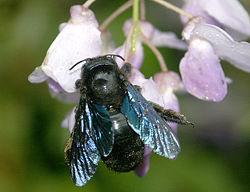| Xylocopa valga | |
|---|---|
 | |
| Carpenter-bee (Xylocopa valga) foraging Chinese wisteria ( Wisteria sinensis ) flowers. | |
| Scientific classification | |
| Kingdom: | Animalia |
| Phylum: | Arthropoda |
| Class: | Insecta |
| Order: | Hymenoptera |
| Family: | Apidae |
| Genus: | Xylocopa |
| Species: | X. valga |
| Binomial name | |
| Xylocopa valga Gerstaecker, 1872 [2] | |
Xylocopa valga is a species of carpenter bee common to: western, central and southern Europe, except for far northern latitudes; the Caucasus; Middle East; Central Asia; and Mongolia. [3] The species has become extinct in Latvia and Lithuania. [4]
